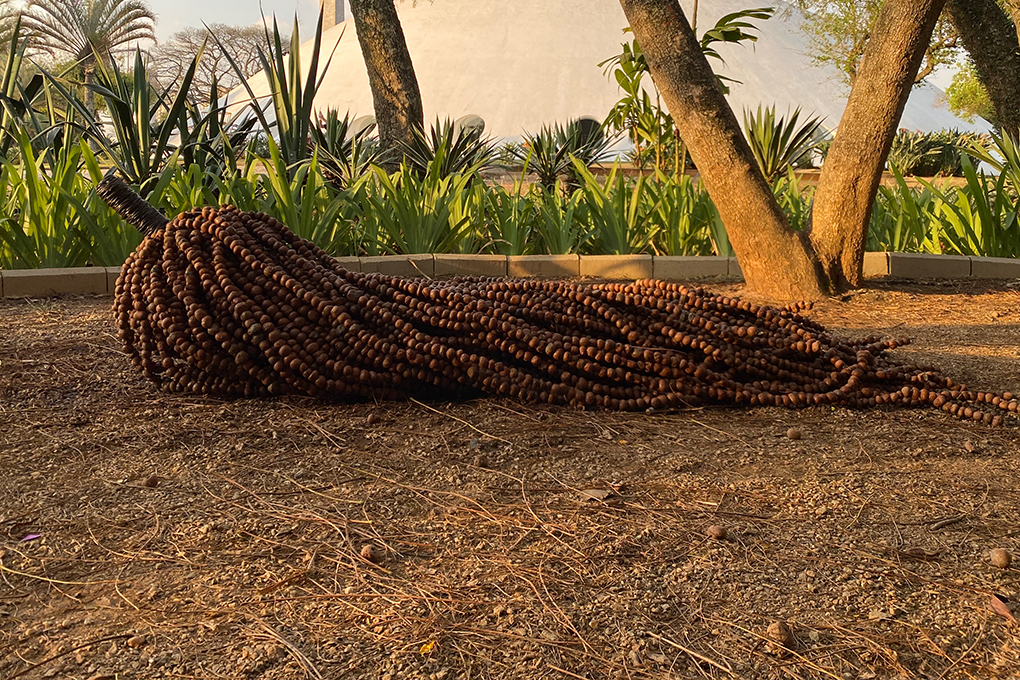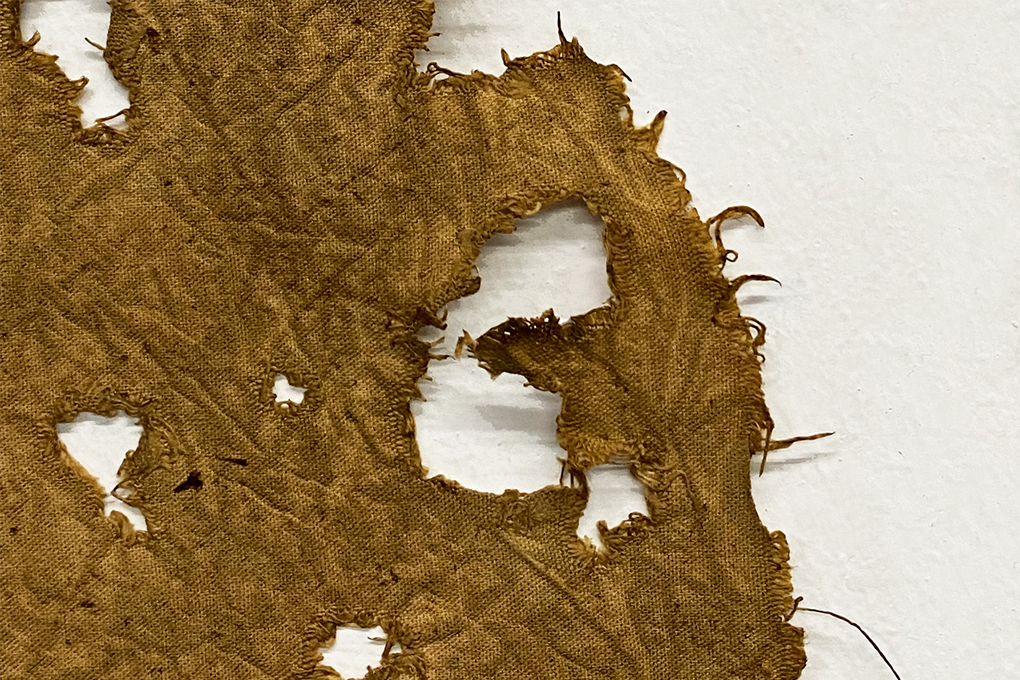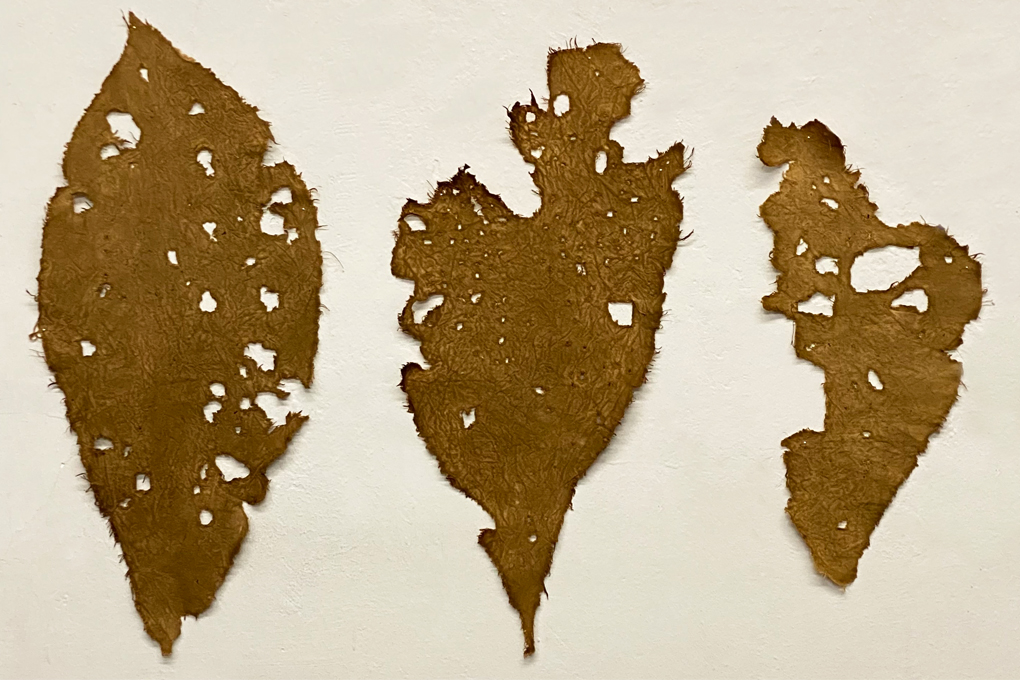“FARDO MOLE, PENCA RAMA”
Solo Show Alexandre Brandão
Text by Miguel Chaia
Opening March 1st 2024. From 6pm until 10pm.
Exhibition March 1st until 13th April.
NOS ENTRECRUZAMENTOS DA ARTE
Miguel Chaia
The exhibition “FARDO MOLE, PENCA RAMA” features four works that explain Brandão’s conceptions and art procedures, based on manual work and the three dimensions explained above (you can immediately see in the title of the show, created by Brandão, a nod to the literature of Guimarães Rosa).
FARDO, iron and annealed wire, 2024.
A work resulting from a grouping of iron rebars used for frames that structure buildings, collected in the urban space where they were discarded. With these rebars, the artist creates bundles joined together by the pressure of annealed wire wheels. In this diptych there is a transmutation of the original idea of bundles of branches used in rural areas or in the countryside to make fire and obtain food, to an idea of collecting and organizing the remains of building carcasses that fall apart in large urban centers. However, the poetics of the original form is so universal that it remains even in the conditions of re-signification of the discards.
The appropriation of scrap metal initiates a process of creation that involves reminiscence, the comparative evaluation of opposing situations and the need for time to act on the wire to better relate to the ferrous skin of the rebar – with the help of some chemical reaction. And so, the wood symbolically undergoes a process of transmutation into iron – in today’s world, following Drummond, even nature is eighty percent iron.
MOLE, putty pigmented with coal dust and powdered clay, 2024.
Three fragile, large sheets of glass found in waste dumps become the supports for interventions with narrow, colored stripes made with putty. The glass already bears the marks of time, noticeable in the thin film of dust impregnated on the surface and in the fine scratches that randomly draw records of the long past. In these fields with their own histories, Brandão draws or writes his personal saga.
After several tests on a smaller scale, the artist rolls out narrow “worms” using the ceramic technique with putty already tinted with charcoal pigments or with other greenish or yellowish pigments used to give each work a unique color. Thus, pressing and flattening the rolls, he builds winding and labyrinthine paths / trains, producing shuffling, overlapping images in various directions without the security of coming and going. The glass is written on, suggesting maps of labyrinths that we must unravel.
In this work, the stripes that refer to drawing immediately stand out, but the lines become volumes, the volumes tend towards three-dimensionality, the matter carries colors. Here, Brandão shuffles languages, as painting, drawing and sculpture are found in the same work. Mole is not the support, but the material handled, tamed by manual action that weaves long paths of monochromatic colors, creating movements, lights, shadows and reliefs. In Mole, the transparency of glass (which lets light through) and the opacity of the sculptural/pictorial mass (which retains light) coexist. The artist’s bodily presence can be seen in every centimeter of these strips, as his fingerprints, the marks of his fingers’ pressure, have been recorded in the mass in an effort to give direction to the flow of the material used.
In this work, the smooth glass support welcomes multiplicity and simultaneity, as it is difficult to define the boundaries between drawing, painting, three-dimensional object and process.
PENCA, expanded clay and annealed wire, 2023.
In the same vein as Fardo, Brandão’s way of bringing multiplicity and simultaneity to give expression to the collective or the grouping is made clear, since Penca emulates a bunch of coconuts growing on the tops of coconut trees. And there, too, you can see the reminiscences of the rural world. Or rather, nature. We can see that Brandão is constantly making a pendulum movement between the rural world and the urban-industrial world; between nature and culture.
Branches, leaves and fruit are ostensibly present in these four works in the exhibition as references for conceiving and structuring the works, in a process of re-signifying nature (critically and aesthetically). Just as the means for such production are also sought in the mutations of the natural, biological, chemical or physical world.
It’s worth highlighting a work that Brandão has been developing over the years, in the form of a systematically monitored artistic experiment – a work in process.
This is Temporã, which the artist began in 2014 and is still working on today. It consists of a circular sequence of jabuticabas joined together with sewing thread. The artist produced a necklace with these fruits, measuring around 10 centimeters in diameter, resembling a jewel of large black pearls, with each fruit at a specific moment of ripening/rotting. Each fruit is in a stage of withering or in a moment of resistance. For ten years, this work has seen both nature fighting against time and art embracing vital botanical reactions.
Penca was exhibited in 2023 in the gardens of the São Paulo Museum of Modern Art (MAM), in Ibirapuera Park, and has now been moved to a white cube, in a process equivalent to moving from nature to a cultural environment. Given its conception, the work is able to move between environments, as it has the power of simultaneity. Before, Penca was stretched out on the grass; now he is exposed on the concrete. This phenomenon correlates with Brandão’s way of making: returning to nature through the artificiality of art and technology, which allow the clay to expand and make existence possible, whether in natural or artificial circumstances.
RAMA, lemon juice on unbleached cotton fabric, heated with an iron, 2024.
This work is made up of two dozen fabrics cut from the matrices of large leaves collected in the forest, from the same family of vegetation and in a state of preservation specific to each one – some whole, others in pieces or parts due to the action of time. The different stages of the leaves’ condition leave them complete or in fragments, making up a set of different forms created from the vegetation. And so, after collection and selection, each of these units becomes a matrix for cutting out of cotton fabric, keeping the marks of its natural deterioration (an aspect reminiscent of the work Temporã). These fabric cut-outs will be moistened with lemon juice and heated with an iron, in a chemical process previously researched and accepted by the artist
São Paulo, February 2024.
Miguel Chaia has a master’s and doctorate in Sociology from USP. Professor of Politics in the Social Sciences Course and in the Postgraduate Program in Social Sciences at PUC-SP. Researcher and coordinator of the Center for Studies in Art, Media and Politics (Neamp). Author of articles and books on political philosophy and Brazilian art.





